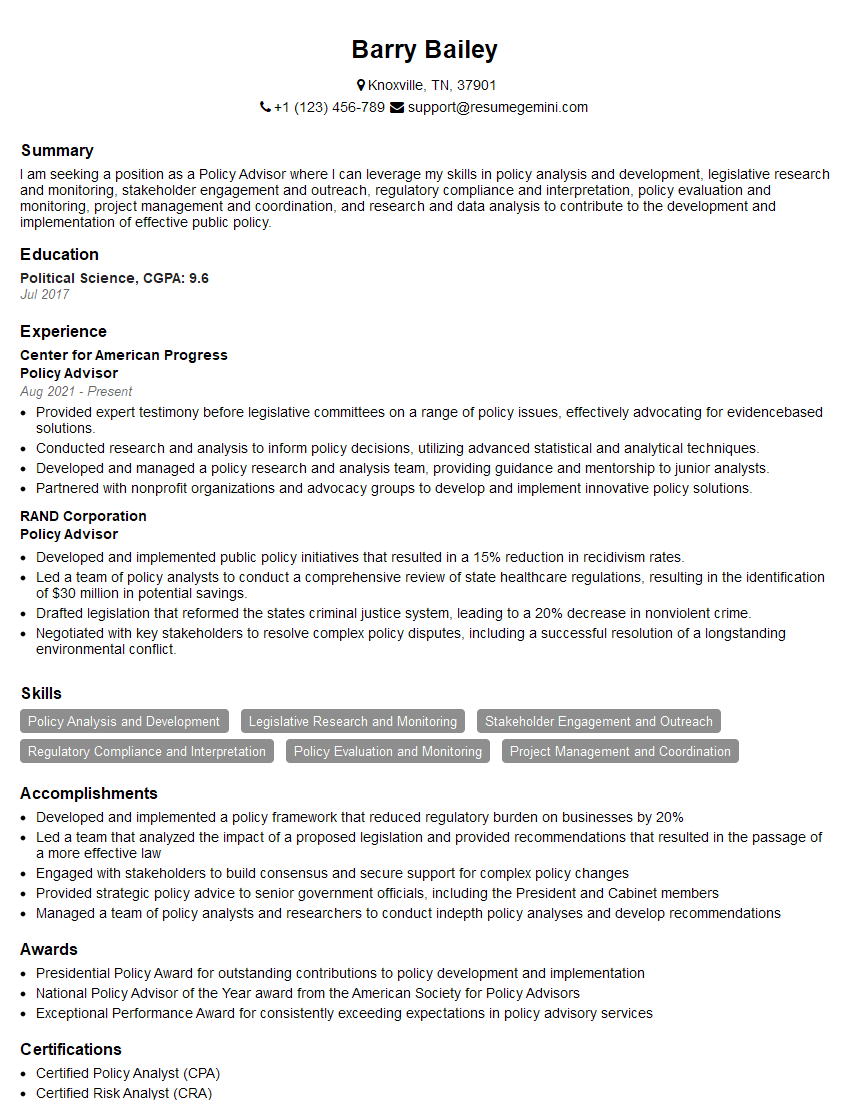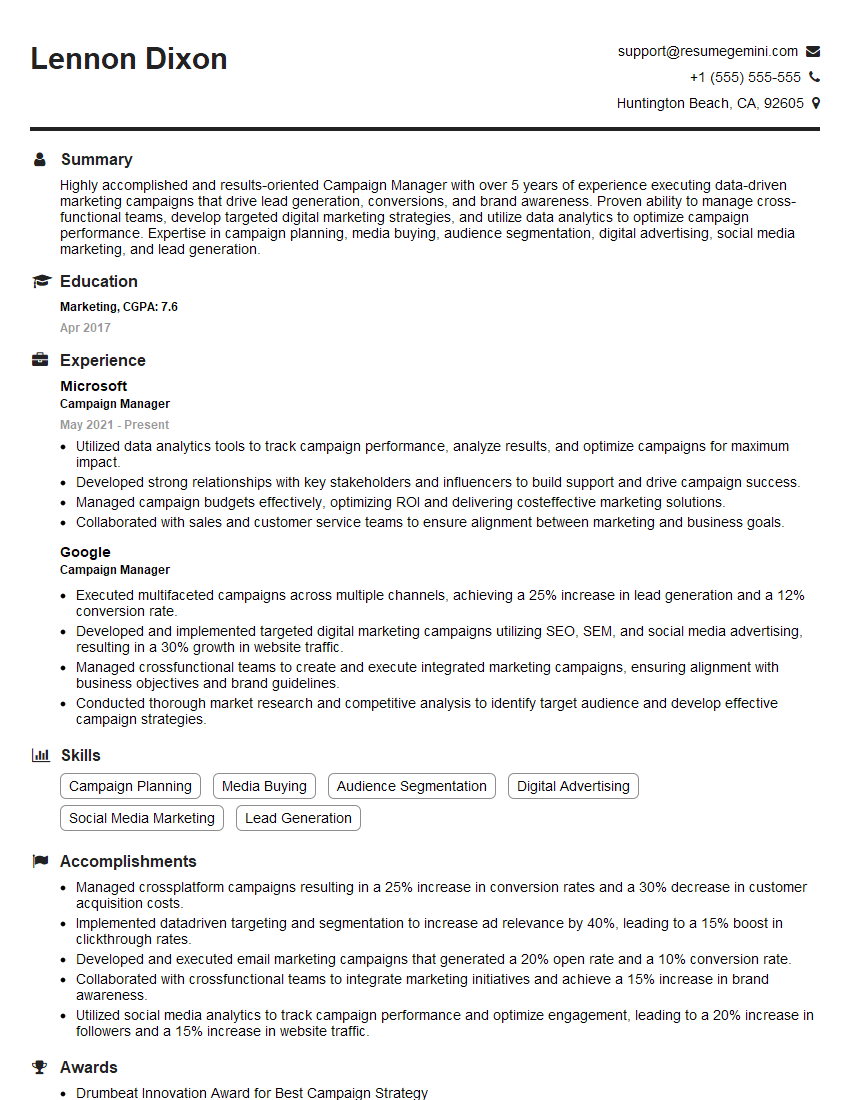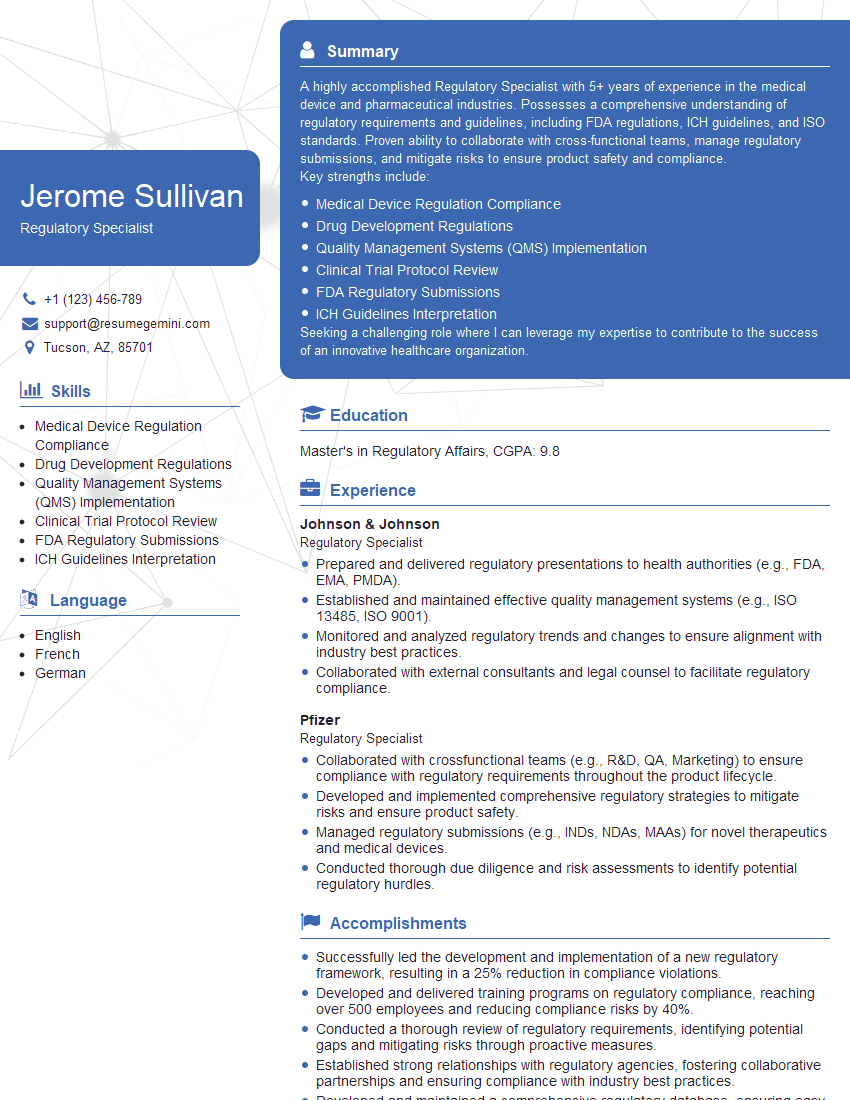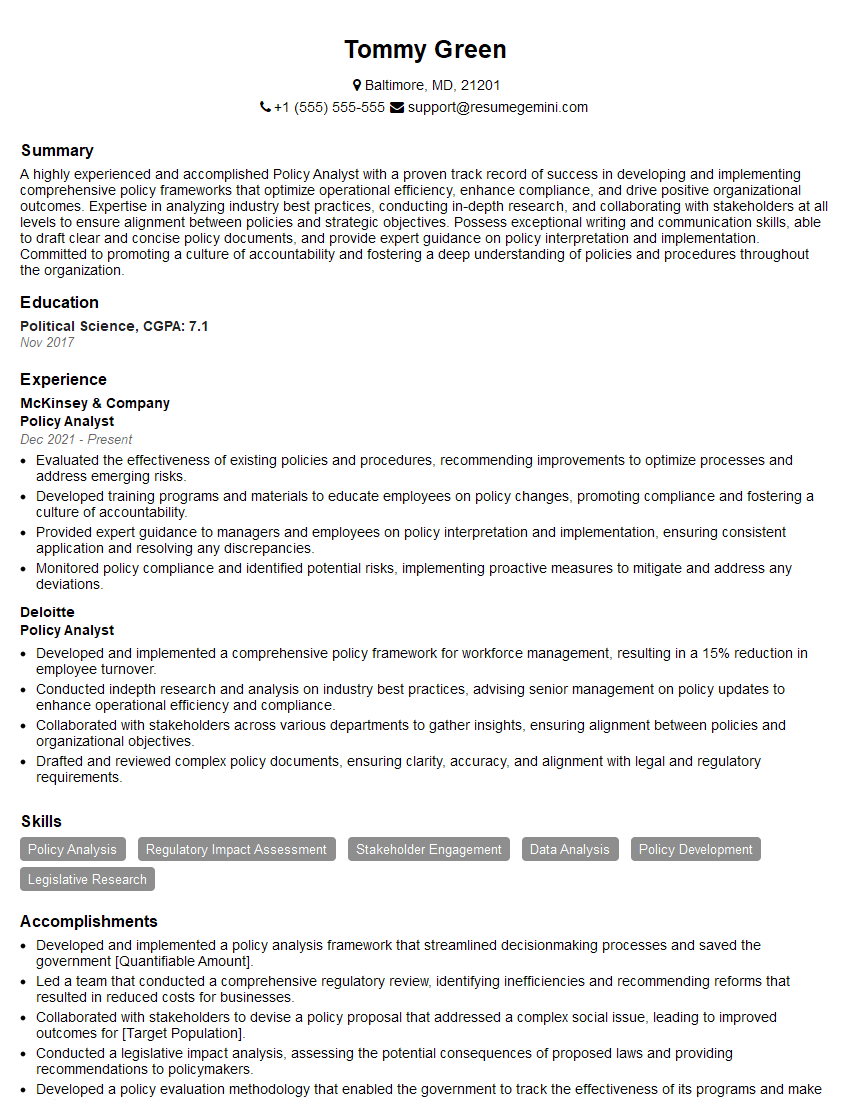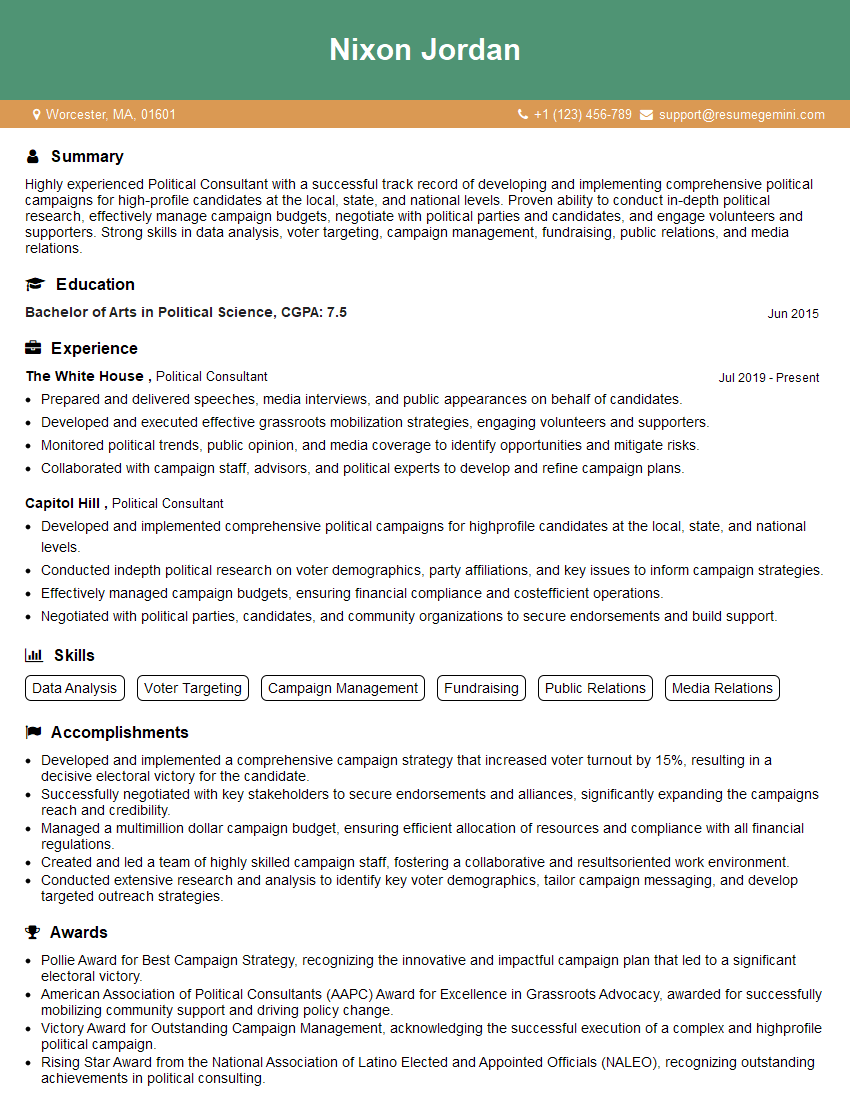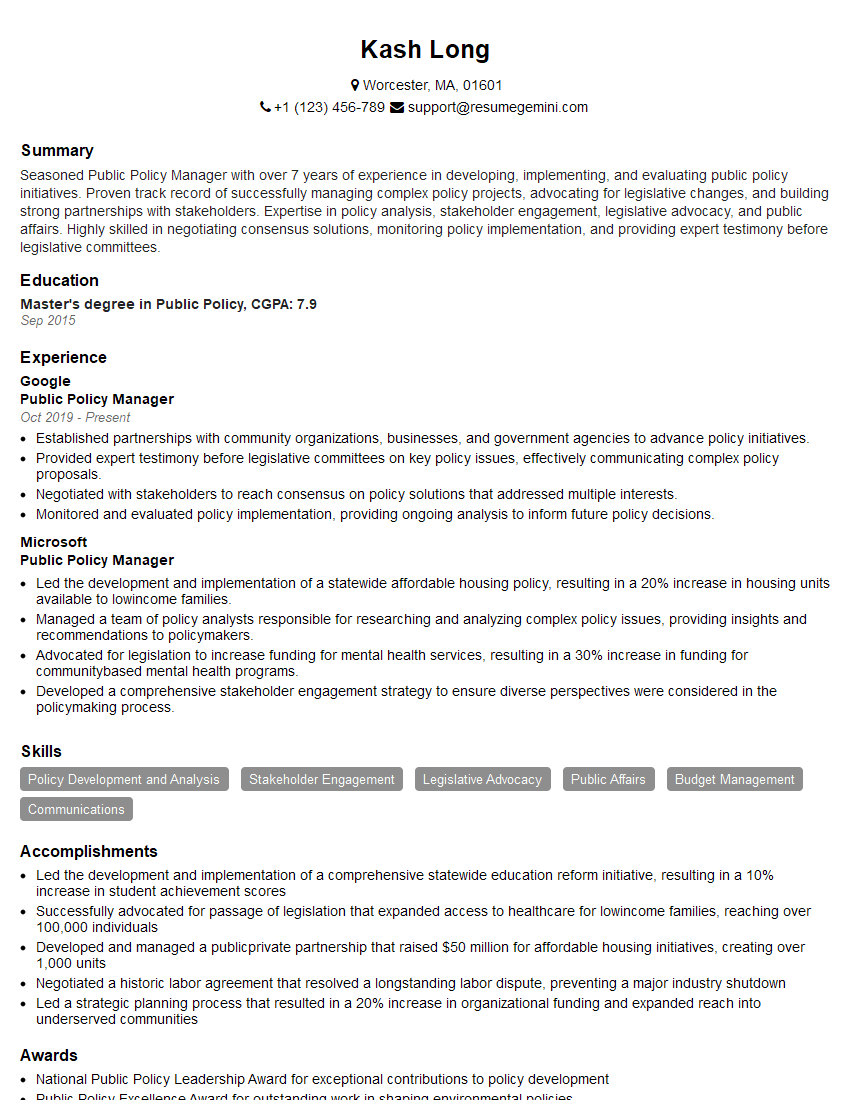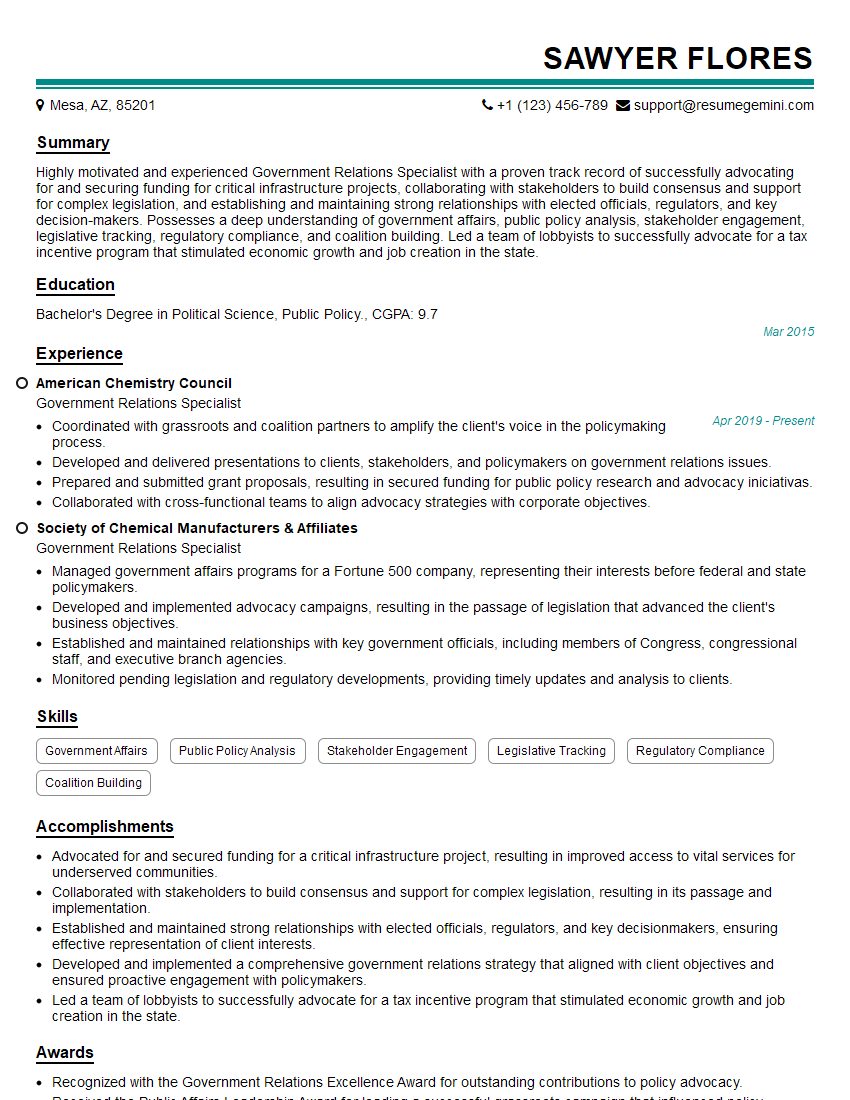The thought of an interview can be nerve-wracking, but the right preparation can make all the difference. Explore this comprehensive guide to Policy and Advocacy Development interview questions and gain the confidence you need to showcase your abilities and secure the role.
Questions Asked in Policy and Advocacy Development Interview
Q 1. Describe your experience developing policy recommendations.
Developing effective policy recommendations requires a rigorous and multi-faceted approach. It begins with a deep understanding of the problem, involving thorough research and data analysis to identify root causes and potential solutions. I’ve consistently employed a structured process involving:
- Problem Definition: Clearly articulating the policy challenge, including its scope, impact, and affected stakeholders.
- Research and Analysis: Gathering evidence from various sources, including academic literature, government reports, statistical data, and stakeholder interviews, to inform the proposed solutions.
- Option Generation: Exploring a range of policy options, considering their feasibility, cost-effectiveness, and potential consequences.
- Impact Assessment: Evaluating the potential positive and negative impacts of each policy option, using qualitative and quantitative methods.
- Recommendation Formulation: Selecting the most promising policy option based on the analysis and presenting it with clear justification.
For example, in my work on improving access to healthcare in underserved communities, I conducted extensive research on existing programs, interviewed community leaders and healthcare providers, and analyzed demographic data to develop recommendations for targeted funding, improved infrastructure, and community-based health initiatives.
Q 2. Explain your approach to stakeholder engagement in policy advocacy.
Stakeholder engagement is critical to successful policy advocacy. My approach is built on principles of inclusivity, transparency, and mutual respect. I believe in a collaborative process, not a top-down approach. This involves:
- Identifying Key Stakeholders: Carefully identifying all individuals and groups impacted by the policy, including those who may support or oppose it.
- Building Relationships: Establishing trust and rapport with stakeholders through open communication and active listening.
- Utilizing Diverse Engagement Methods: Employing a variety of techniques including public forums, focus groups, surveys, interviews, and online consultations to reach diverse stakeholders.
- Facilitating Dialogue: Creating a space for open dialogue and respectful exchange of ideas, even amongst conflicting viewpoints.
- Addressing Concerns: Actively listening to and addressing stakeholder concerns and incorporating feedback into the policy development process.
For instance, when advocating for environmental protection legislation, I organized community meetings, conducted surveys to gauge public opinion, and met individually with industry representatives to address their concerns about potential economic impacts. This resulted in a more balanced and widely accepted policy.
Q 3. How do you prioritize competing policy objectives?
Prioritizing competing policy objectives requires a systematic and transparent approach. I typically employ a multi-criteria decision analysis (MCDA) framework. This involves:
- Identifying Objectives: Clearly defining all policy objectives and their relative importance.
- Establishing Criteria: Developing measurable criteria to evaluate the performance of each objective, such as cost-effectiveness, equity, and environmental impact.
- Weighting Criteria: Assigning weights to each criterion based on their relative importance.
- Evaluating Options: Evaluating each policy option against the established criteria and weighting system.
- Selecting the Optimal Option: Choosing the option that best achieves the prioritized objectives based on the overall score.
Imagine a scenario where a city needs to improve public transportation while also managing budget constraints. Using MCDA, we could weigh factors like cost, environmental impact, accessibility for different demographics, and potential economic benefits. This allows for a rational choice that balances different, potentially conflicting, priorities.
Q 4. What methods do you use to analyze policy effectiveness?
Analyzing policy effectiveness requires a combination of quantitative and qualitative methods. This involves:
- Setting Measurable Indicators: Defining specific, measurable, achievable, relevant, and time-bound (SMART) indicators to track the impact of the policy.
- Data Collection: Gathering data from relevant sources, such as government statistics, surveys, and program evaluations.
- Statistical Analysis: Using statistical methods to analyze data and assess the impact of the policy on the chosen indicators.
- Qualitative Assessment: Conducting interviews, focus groups, or case studies to gather qualitative data and understand the lived experiences of those affected by the policy.
- Impact Evaluation: Comparing pre- and post-policy data to assess the changes attributable to the policy intervention.
For example, to evaluate the effectiveness of a job training program, we would track employment rates, income levels, and participant satisfaction. Qualitative data from interviews would provide richer context on participant experiences and challenges.
Q 5. Describe your experience with policy research and data analysis.
My experience in policy research and data analysis is extensive. I am proficient in various quantitative and qualitative methods, including statistical software packages like R and SPSS, and qualitative data analysis software like NVivo. My work has involved:
- Data Collection and Management: Designing data collection instruments, conducting surveys, and managing large datasets.
- Statistical Analysis: Performing regression analysis, hypothesis testing, and other statistical techniques to analyze data and draw conclusions.
- Qualitative Data Analysis: Conducting thematic analysis, grounded theory, and other qualitative methods to analyze textual and interview data.
- Data Visualization: Creating charts, graphs, and other visualizations to effectively communicate research findings.
- Report Writing: Preparing clear, concise, and evidence-based reports that communicate research findings to various audiences.
In a recent project on the impact of climate change on agriculture, I used statistical modeling to predict future crop yields under different climate scenarios. This informed policy recommendations for climate-resilient agricultural practices.
Q 6. How do you build consensus amongst diverse stakeholders on policy issues?
Building consensus among diverse stakeholders is a crucial skill in policy advocacy. It requires strong communication, negotiation, and conflict resolution skills. My approach involves:
- Identifying Common Ground: Identifying shared goals and values among stakeholders, even if they have differing perspectives on how to achieve them.
- Facilitating Dialogue: Creating a safe and respectful space for open dialogue and exchange of ideas.
- Active Listening: Actively listening to all stakeholders’ perspectives and demonstrating empathy and understanding.
- Negotiation and Compromise: Finding common ground through negotiation and compromise, ensuring that all stakeholders feel heard and valued.
- Building Coalitions: Building coalitions of support around the policy by bringing together stakeholders with shared interests.
During a campaign for improved public education funding, I worked with teachers’ unions, parent groups, and business leaders to highlight the economic benefits of education and build a broad base of support for increased funding.
Q 7. Explain your understanding of the legislative process.
My understanding of the legislative process is comprehensive. I know that it typically involves several key stages:
- Bill Drafting: A bill is drafted, outlining the proposed policy changes.
- Introduction: The bill is introduced in the legislature by a legislator.
- Committee Consideration: The bill is referred to a relevant committee for review and hearings.
- Floor Debate and Vote: The bill is debated and voted on by the full legislature.
- Passage to Other Chamber: If passed, the bill is sent to the other chamber of the legislature (e.g., Senate to House, or vice-versa) for consideration.
- Conference Committee: If the two chambers pass different versions of the bill, a conference committee is formed to reconcile differences.
- Executive Action: The bill is sent to the executive branch (e.g., governor or president) for signature or veto.
- Implementation: Once signed into law, the policy is implemented by the relevant government agencies.
I understand the importance of lobbying and advocacy at each stage of this process to ensure the policy’s successful passage and implementation. Knowing the specific rules and procedures within different legislative bodies is essential for effective advocacy.
Q 8. How do you adapt your advocacy strategies to different audiences?
Adapting advocacy strategies requires understanding your audience’s values, communication styles, and priorities. It’s not a ‘one-size-fits-all’ approach. Think of it like tailoring a suit – you wouldn’t use the same pattern for a businessman and a teenager.
- For policymakers: Focus on concise, data-driven arguments highlighting policy implications, budget impact, and potential legislative solutions. Use formal language and cite relevant research and legal precedents. For example, when advocating for increased funding for public education, I’d present data on student achievement gaps correlated with funding levels, propose specific budgetary allocations, and cite relevant legislation.
- For the general public: Prioritize clear, compelling narratives that resonate emotionally. Use simple language, relatable stories, and visuals to convey the issue’s importance. For example, I might share a personal story of a child positively impacted by a program you’re advocating for to create empathy.
- For media: Craft compelling soundbites and press releases that highlight newsworthy aspects of the issue. Provide concise summaries and direct quotes for easy dissemination. For example, highlighting a new study’s findings on a specific policy issue and offering a concise statement summarizing the findings and advocating a particular action.
Ultimately, successful advocacy relies on tailoring your message to connect with each specific audience’s motivations and concerns.
Q 9. Describe your experience with writing policy briefs or reports.
I have extensive experience writing policy briefs and reports, focusing on clarity, conciseness, and persuasive argumentation. My reports always follow a structured format:
- Executive Summary: A brief overview of the key findings and recommendations.
- Background: Contextual information outlining the problem and its significance.
- Analysis: Data-driven analysis supporting the arguments. This often includes graphs, charts and tables.
- Recommendations: Clear, actionable policy recommendations.
- Conclusion: A summary reinforcing the key arguments and recommendations.
For example, I recently authored a report on the impact of minimum wage increases on small businesses. The report included economic modeling, case studies of businesses, and interviews with business owners. The data was presented visually to make it accessible and compelling, and the recommendations were specific and actionable, such as phased implementation and targeted tax credits. I ensured the language was clear and accessible to both policymakers and the general public.
Q 10. How do you measure the success of a policy advocacy campaign?
Measuring the success of a policy advocacy campaign requires a multifaceted approach, going beyond simply whether the desired policy change was enacted. We need to track several metrics.
- Policy Changes: Did the campaign result in legislative changes, regulatory shifts, or shifts in policy implementation? This is the most obvious metric of success, but it’s not always the end goal.
- Public Awareness and Opinion: Did the campaign increase public awareness and understanding of the issue? Did it shift public opinion in the desired direction? We can measure this through surveys, polls, and media monitoring.
- Stakeholder Engagement: Did the campaign successfully engage with key stakeholders, including policymakers, businesses, community groups, and the media? This can be tracked by recording meetings, media coverage, and social media engagement.
- Resource Mobilization: Did the campaign effectively mobilize resources, such as funding, volunteers, and media attention? This involves tracking financial resources, volunteer hours, and media mentions.
For instance, a successful campaign might not achieve the full legislative change it sought, but it could still be deemed successful if it significantly increased public awareness and shifted public opinion, paving the way for future policy changes.
Q 11. How familiar are you with relevant government regulations and legislation?
I possess a strong understanding of relevant government regulations and legislation. My knowledge is regularly updated through continuous monitoring of legislative developments, legal research, and engagement with government officials and legal experts. I am proficient in using legal databases and researching specific statutes, regulations, and case law. My knowledge encompasses both federal and state-level regulations, as well as international treaties where relevant.
For example, in a recent campaign related to environmental protection, my in-depth knowledge of the Clean Air Act and relevant EPA regulations was crucial in crafting effective advocacy strategies and ensuring our recommendations were legally sound and feasible.
Q 12. Explain your approach to crisis communication in the context of policy controversies.
My approach to crisis communication during policy controversies centers on transparency, proactive engagement, and consistent messaging. The key is to anticipate potential challenges and have a plan in place.
- Rapid Response: Acknowledge the issue quickly and directly. Don’t wait for the media or your opponents to define the narrative.
- Transparent Communication: Provide accurate and complete information to the public, stakeholders, and the media. Address concerns honestly and directly, even if it means admitting mistakes.
- Consistent Messaging: Develop a consistent message that is repeated across all communication channels. This ensures clarity and prevents conflicting information from confusing the public.
- Stakeholder Engagement: Proactively engage with stakeholders to address their concerns and build consensus. This includes meeting with policymakers, community leaders, and the media.
For example, if a policy we advocated for faced unexpected negative consequences, we’d immediately issue a statement acknowledging the problem, outlining the steps being taken to address it, and emphasizing our commitment to finding solutions. We would engage proactively with critics to understand their concerns and explore potential solutions collaboratively.
Q 13. How do you handle setbacks or opposition in policy advocacy?
Setbacks and opposition are inevitable in policy advocacy. My approach focuses on resilience, adaptability, and strategic re-evaluation.
- Analyze the Setback: Carefully analyze the reasons for the setback. Was it due to a lack of resources, weak messaging, strong opposition, or other factors?
- Adapt the Strategy: Based on the analysis, adapt the strategy. This might involve refining the message, targeting different stakeholders, seeking new alliances, or adjusting the timeline.
- Learn from Mistakes: Treat setbacks as learning opportunities. What could have been done differently? How can the campaign be improved?
- Maintain Momentum: Even during setbacks, it’s important to maintain momentum. This can involve focusing on smaller wins, celebrating successes, and keeping stakeholders engaged.
For example, if a proposed bill we supported was defeated, we’d analyze why, perhaps discovering a need for greater grassroots mobilization or improved communication with key legislators. We’d use this information to adjust our strategy for future legislative efforts.
Q 14. Describe your experience working with diverse teams and individuals.
I thrive in diverse team environments. My experience includes working with individuals from various backgrounds, expertise levels, and communication styles. I believe that diverse perspectives are essential for effective policy advocacy. My approach emphasizes collaboration, communication, and mutual respect.
- Active Listening: I actively listen to and value the perspectives of all team members, ensuring everyone feels heard and respected.
- Clear Communication: I use clear and concise communication to ensure everyone understands the goals, strategies, and roles.
- Collaborative Problem-Solving: I encourage collaborative problem-solving, leveraging the diverse skills and perspectives of the team.
- Conflict Resolution: I am skilled in mediating conflicts and finding solutions that satisfy all stakeholders.
In a recent project, our team comprised researchers, community organizers, and legal experts. Successfully navigating differing perspectives and approaches required active listening, clear communication, and a commitment to finding common ground. The result was a more comprehensive and effective advocacy strategy.
Q 15. How do you leverage data and evidence to support your policy arguments?
Data and evidence are the bedrock of any strong policy argument. I don’t just present opinions; I build cases using rigorous, credible information. This involves several key steps:
- Identifying relevant data sources: This could range from government statistics and academic research to reports from NGOs and think tanks. The choice depends on the specific policy issue and the desired impact.
- Analyzing data for trends and patterns: I use statistical software and analytical techniques to identify significant trends, correlations, and causal relationships. For instance, if advocating for increased funding for public health, I’d analyze disease prevalence rates, healthcare access statistics, and economic impacts of illness.
- Visualizing data effectively: Charts, graphs, and infographics are crucial for communicating complex data clearly and concisely to diverse audiences. A compelling visual can often make a stronger impact than pages of raw data.
- Presenting evidence strategically: The order and framing of evidence are vital. I tailor the presentation to my audience, acknowledging counterarguments and addressing potential weaknesses in the evidence proactively. For example, while presenting to a conservative group, I might focus on cost-benefit analyses, while addressing a liberal group I would emphasize the ethical implications.
For example, in a campaign to improve air quality, I’d use air quality index data, public health statistics on respiratory illnesses, and economic studies on lost productivity due to pollution to build a compelling case for stricter emission standards.
Career Expert Tips:
- Ace those interviews! Prepare effectively by reviewing the Top 50 Most Common Interview Questions on ResumeGemini.
- Navigate your job search with confidence! Explore a wide range of Career Tips on ResumeGemini. Learn about common challenges and recommendations to overcome them.
- Craft the perfect resume! Master the Art of Resume Writing with ResumeGemini’s guide. Showcase your unique qualifications and achievements effectively.
- Don’t miss out on holiday savings! Build your dream resume with ResumeGemini’s ATS optimized templates.
Q 16. How do you identify and address ethical considerations in policy advocacy?
Ethical considerations are paramount in policy advocacy. Ignoring them can undermine credibility and damage the very cause you’re fighting for. My approach involves:
- Identifying potential ethical conflicts: This includes considering the potential impacts of the policy on different groups, potential biases in data or research, and transparency in funding and relationships.
- Applying ethical frameworks: Utilitarianism, deontology, and virtue ethics can provide different lenses for evaluating the ethical implications of a policy proposal. For example, a utilitarian approach would prioritize the policy that maximizes overall well-being, while a deontological approach would focus on the inherent rights and duties involved.
- Engaging in inclusive dialogue: Ethical decision-making is rarely a solitary exercise. I actively seek input from diverse stakeholders, including affected communities, to ensure that all perspectives are considered.
- Maintaining transparency: Openness about data sources, funding, and potential conflicts of interest is crucial for building trust and credibility. I believe in making my work and methodology accessible.
For instance, when advocating for a new education policy, I would meticulously assess its impact on different student populations (e.g., students with disabilities, students from low-income backgrounds), ensuring equitable outcomes for all.
Q 17. How do you stay current with relevant policy developments?
The policy landscape is constantly evolving, so continuous learning is essential. My strategies include:
- Subscribing to relevant newsletters and publications: Staying informed requires access to reputable sources. I follow publications like the Congressional Research Service reports, think tank publications, and specialized journals.
- Attending conferences and workshops: These events offer opportunities to network with other professionals, learn about cutting-edge research, and engage in direct discussions with policymakers.
- Monitoring legislative activity: Tracking bills and proposed legislation is crucial to understand the policy agenda. I use online resources to track legislation at local, national and international levels.
- Networking with policymakers and stakeholders: Building relationships with individuals involved in the policymaking process provides valuable insights and opportunities for influencing policy decisions.
I also actively participate in online communities and discussion forums focused on specific policy areas to stay abreast of current debates and emerging trends. For instance, I regularly engage in Twitter chats and LinkedIn groups related to environmental policy.
Q 18. Explain your experience with budget analysis related to policy initiatives.
Budget analysis is an integral part of policy development. I have extensive experience evaluating the financial implications of policy proposals. My approach involves:
- Understanding the budgetary context: This includes analyzing existing budgets, revenue projections, and spending priorities.
- Estimating the costs and benefits of a policy: This often requires using cost-benefit analysis techniques to assess the economic impact of the policy proposal. I’ll consider both direct and indirect costs and benefits, including both tangible and intangible effects.
- Identifying funding sources: This might involve exploring various funding mechanisms, such as tax increases, spending cuts in other areas, or public-private partnerships.
- Developing a comprehensive budget proposal: This should clearly outline all the costs and revenue streams associated with the policy.
In a recent project advocating for affordable housing, I conducted a thorough budget analysis, comparing different funding models and demonstrating the long-term cost savings associated with proactive investment in affordable housing versus the escalating costs of homelessness and related social services.
Q 19. How do you use social media and digital tools for policy advocacy?
Social media and digital tools are powerful instruments for policy advocacy. I utilize them to:
- Raise awareness about policy issues: I leverage platforms like Twitter and Facebook to share informative content, engage in discussions, and reach a wider audience.
- Mobilize support for policy initiatives: Online petitions, social media campaigns, and targeted advertising can be used to gather public support for policy changes.
- Facilitate communication and collaboration: Digital tools enable collaboration with colleagues, stakeholders, and policymakers. I use platforms like Slack and email lists to facilitate information sharing.
- Track policy developments and public opinion: Social media monitoring tools allow me to track discussions about policy issues, identify key influencers, and gauge public sentiment.
For example, during a campaign to ban single-use plastics, I used Instagram to share visually compelling content highlighting the environmental damage caused by plastic pollution, alongside links to petitions and action plans.
Q 20. Describe your experience presenting policy proposals to diverse audiences.
Presenting policy proposals to diverse audiences requires tailoring your message to resonate with different values and perspectives. My approach involves:
- Understanding your audience: Before presenting, I thoroughly research my audience’s background, knowledge level, and interests.
- Crafting a clear and concise message: I avoid jargon and use simple language that everyone can understand. I also use visual aids like charts and graphs to enhance understanding.
- Tailoring your presentation style: My presentation style adapts to the audience; a formal presentation to a legislative committee differs significantly from a community town hall.
- Anticipating questions and concerns: I prepare answers to potential questions and objections beforehand to enhance my responsiveness during the Q&A session.
- Building rapport and trust: I strive to create a positive and engaging atmosphere to build trust and rapport with the audience.
I once presented a proposal for community-based policing to a group of residents who were initially skeptical of law enforcement. By acknowledging their concerns, demonstrating the policy’s benefits, and emphasizing community input, I successfully gained their support.
Q 21. How do you negotiate and compromise to achieve policy goals?
Negotiation and compromise are essential skills in policy advocacy. Rarely does a policy proposal pass exactly as initially envisioned. My approach involves:
- Identifying common ground: Finding areas of agreement with opposing parties is crucial for building consensus.
- Prioritizing key objectives: I distinguish between core goals and secondary considerations, allowing for flexibility in less critical areas.
- Building relationships: Strong relationships with stakeholders are essential for productive negotiations. Trust and mutual respect are key to finding common ground.
- Active listening and empathy: Understanding opposing viewpoints is crucial for effective negotiation.
- Creative problem-solving: Finding innovative solutions that address multiple concerns is often more effective than inflexible adherence to a rigid plan.
For example, in negotiations over environmental regulations, I might compromise on the timeline for implementation to secure support from businesses while maintaining the core environmental protections.
Q 22. Explain your understanding of the policy-making process at both local and national levels.
The policy-making process, while varying in specifics, follows a similar pattern at both local and national levels. It generally involves:
- Agenda Setting: Identifying the problems needing solutions. At the local level, this might involve citizen complaints about potholes; nationally, it could be addressing climate change.
- Policy Formulation: Developing potential solutions. This often includes research, consultations with experts and stakeholders, and drafting policy proposals. Locally, this could involve discussions at town hall meetings; nationally, it involves extensive research and committee hearings.
- Policy Adoption: The formal approval of a policy by the relevant decision-making body. At the local level, this might be a city council vote; nationally, it involves legislative votes in Congress or Parliament.
- Policy Implementation: Putting the policy into action. This involves the bureaucracy, local governments, and potentially private sector partners. Locally, this could be the actual repair of potholes; nationally, it involves regulatory agencies enforcing new environmental regulations.
- Policy Evaluation: Assessing the effectiveness of the policy and making adjustments as needed. This is crucial to ensure that policies achieve their intended goals and are efficient. Evaluation methods include data analysis and public feedback, used at both local and national scales.
While the scale and complexity differ significantly, the fundamental stages remain consistent. National policy-making involves more layers of bureaucracy and often larger budgets and stakeholder groups, but the core principles of problem identification, solution development, implementation, and evaluation are universal.
Q 23. How do you evaluate the potential impact of policy changes?
Evaluating the potential impact of policy changes requires a multi-faceted approach. I employ a combination of methods, including:
- Quantitative Analysis: Using statistical modeling and data analysis to predict the numerical impact of a policy. For example, I might use economic modeling to project job creation or cost savings from a proposed tax policy.
- Qualitative Analysis: Exploring the non-numerical effects, like public opinion or community impact. This might involve focus groups, surveys, and interviews to understand the potential social and cultural consequences of a policy.
- Cost-Benefit Analysis (CBA): Evaluating the costs and benefits of a policy, both financial and non-financial, to determine whether the benefits outweigh the costs. This provides a structured framework for decision-making.
- Scenario Planning: Considering different potential outcomes and developing strategies to address unexpected challenges. This helps to build resilience into policy design and implementation.
A critical aspect is considering unintended consequences. For example, a policy intended to reduce traffic congestion might unexpectedly lead to increased air pollution in a certain area. Thorough evaluation helps mitigate such risks.
Q 24. How do you manage competing priorities and deadlines in a fast-paced policy environment?
Managing competing priorities and deadlines in a fast-paced policy environment demands strong organizational skills and strategic prioritization. My approach involves:
- Prioritization Matrix: Ranking tasks based on urgency and importance using a framework like Eisenhower Matrix (urgent/important). This helps focus efforts on high-impact activities first.
- Project Management Tools: Utilizing project management software like Asana or Trello to track tasks, deadlines, and progress. This helps to maintain transparency and accountability.
- Effective Communication: Maintaining open and clear communication with stakeholders to manage expectations and coordinate efforts. Regular updates and meetings are vital.
- Delegation and Teamwork: Assigning tasks to appropriate team members and leveraging their expertise to maximize efficiency. Collaboration is key to handling multiple projects simultaneously.
- Flexibility and Adaptability: Recognizing that priorities can shift rapidly and adjusting plans as needed to respond to new information or events. Rigidity is the enemy of success in this field.
Think of it like conducting an orchestra – many instruments playing different parts, all needing to be coordinated to create a harmonious whole. Successful policy development requires the same level of coordination and adaptability.
Q 25. Describe your experience working with lobbying firms or interest groups (if applicable).
My experience includes collaboration with several lobbying firms and interest groups, representing diverse perspectives on various policy issues. These collaborations have been crucial for:
- Gaining insights into stakeholder perspectives: Lobbying firms and interest groups often possess valuable knowledge about the specific needs and concerns of their constituents.
- Building broader coalitions: Working with diverse groups allows for the creation of broader support for policy proposals, increasing the likelihood of success.
- Developing effective advocacy strategies: Lobbying firms often possess expertise in navigating the legislative process and developing effective advocacy campaigns.
- Ensuring effective communication: Collaborating with these groups helps to tailor policy messaging to resonate with different target audiences.
However, it is crucial to maintain objectivity and ethical standards when working with such groups. It is essential to understand their interests and ensure that policy recommendations are grounded in evidence and the public interest, not just the interests of specific groups.
Q 26. How do you anticipate and respond to potential criticisms of your policy proposals?
Anticipating and addressing potential criticisms is vital for successful policy advocacy. I approach this by:
- Proactive Identification of Potential Weaknesses: Rigorously reviewing policy proposals for potential flaws or areas of vulnerability to criticism. This often involves peer review and testing policy ideas with diverse stakeholders.
- Developing Counterarguments: Preparing responses to anticipated criticisms, backed by evidence and data. This might involve addressing specific concerns raised by opponents or highlighting the benefits of the policy that they might overlook.
- Transparency and Openness: Being transparent about the policy development process and rationale, sharing data and methodologies with stakeholders. This builds trust and allows for constructive feedback.
- Engagement and Dialogue: Actively engaging with critics in respectful dialogue, acknowledging valid concerns, and being open to modifying the policy based on feedback. Constructive dialogue can significantly enhance the quality of policy and increase acceptance.
Addressing criticisms head-on demonstrates credibility and strengthens the policy proposal by showing that it has been thoroughly vetted and refined.
Q 27. Describe your experience with policy evaluation and impact assessment.
My experience with policy evaluation and impact assessment includes using a range of methods to measure the effectiveness of policies and programs. These include:
- Quantitative Methods: Employing statistical techniques like regression analysis to assess the impact of a policy on specific outcomes, such as crime rates or healthcare access.
- Qualitative Methods: Using interviews, focus groups, and case studies to gain a deeper understanding of the experiences and perspectives of individuals and communities affected by the policy.
- Mixed Methods Approaches: Combining quantitative and qualitative methods to get a holistic view of policy impact. This approach leverages the strengths of both methodologies to achieve a more comprehensive evaluation.
- Developing Evaluation Frameworks: Establishing clear goals and indicators before implementing the policy so that impact can be reliably measured afterward.
For example, I recently evaluated a community development program by tracking changes in employment rates, poverty levels, and access to essential services in the target area, alongside conducting interviews to understand participants’ lived experiences. This mixed-methods approach provided a comprehensive understanding of the program’s effectiveness.
Q 28. How do you build and maintain relationships with key policymakers and stakeholders?
Building and maintaining strong relationships with key policymakers and stakeholders is crucial for effective policy advocacy. My approach centers on:
- Networking and Relationship Building: Actively participating in relevant events, meetings, and conferences to meet and connect with policymakers and stakeholders. This builds familiarity and trust.
- Effective Communication: Maintaining consistent communication through emails, phone calls, and meetings to provide updates, seek input, and build consensus.
- Transparency and Honesty: Being upfront and honest about policy goals, rationale, and potential limitations. This builds trust and credibility.
- Mutual Respect and Understanding: Respecting differing perspectives and viewpoints, even when disagreeing. Seeking common ground fosters collaborative relationships.
- Long-Term Engagement: Understanding that building relationships takes time and consistent effort. Sustained engagement is crucial for building enduring partnerships and influencing long-term policy outcomes.
Think of it as cultivating a garden – it requires consistent nurturing, tending to different needs, and anticipating challenges to yield a bountiful harvest. The same principle applies to building and maintaining successful relationships in policy advocacy.
Key Topics to Learn for Policy and Advocacy Development Interview
- Policy Analysis Frameworks: Understanding different models for analyzing policy effectiveness, including cost-benefit analysis and stakeholder impact assessments. Practical application: Critically evaluating existing policies and proposing improvements based on data and evidence.
- Advocacy Strategies: Developing and implementing effective advocacy campaigns, including identifying key stakeholders, crafting persuasive messaging, and leveraging various communication channels. Practical application: Designing a targeted advocacy strategy to influence a specific policy decision.
- Stakeholder Engagement: Building and maintaining relationships with diverse stakeholders, including government officials, community groups, and the media. Practical application: Facilitating collaborative dialogue and consensus-building among stakeholders with conflicting interests.
- Political Processes & Systems: Understanding the legislative process, regulatory frameworks, and the role of different actors within the policy landscape. Practical application: Navigating bureaucratic processes and effectively influencing policy decisions at various levels of government.
- Research & Data Analysis: Utilizing qualitative and quantitative research methods to inform policy recommendations and advocacy efforts. Practical application: Conducting research to support policy arguments and measuring the impact of advocacy initiatives.
- Communication & Persuasion: Crafting compelling narratives, writing persuasive policy briefs, and presenting policy proposals effectively to diverse audiences. Practical application: Delivering a persuasive presentation to a government committee or public forum.
- Ethical Considerations in Advocacy: Understanding ethical principles and best practices in advocacy, including transparency, accountability, and conflict of interest management. Practical application: Maintaining integrity and building trust with stakeholders.
Next Steps
Mastering Policy and Advocacy Development is crucial for a successful and impactful career. It opens doors to influential roles where you can directly shape societal change. To maximize your job prospects, crafting a strong, ATS-friendly resume is essential. ResumeGemini is a trusted resource that can help you build a professional and impactful resume tailored to highlight your skills and experience in this field. Examples of resumes tailored to Policy and Advocacy Development are available to guide your process. Invest time in creating a compelling resume – it’s your first impression on potential employers.
Explore more articles
Users Rating of Our Blogs
Share Your Experience
We value your feedback! Please rate our content and share your thoughts (optional).
What Readers Say About Our Blog
Live Rent Free!
https://bit.ly/LiveRentFREE
Interesting Article, I liked the depth of knowledge you’ve shared.
Helpful, thanks for sharing.
Hi, I represent a social media marketing agency and liked your blog
Hi, I represent an SEO company that specialises in getting you AI citations and higher rankings on Google. I’d like to offer you a 100% free SEO audit for your website. Would you be interested?
